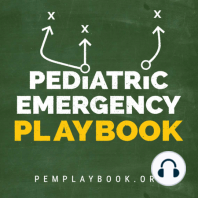30 min listen
GI Bleeding in Children
ratings:
Length:
33 minutes
Released:
Oct 1, 2016
Format:
Podcast episode
Description
Blood in the vomit. Blood in the stool. Blood in the diaper. How far do I go in my investigation? What do I really have to worry about? The differential diagnosis of GI bleeding in children is broad. (Here is the complete differential diagnosis) In the ED, we can simplify by categorizing by age and appearance. Neonates GI bleeding in the neonate (less than one month of age) is serious until proven otherwise. Well appearing? If this in obvious anal fissure, then no further work-up is necessary. Counsel on proper feeding and follow-up. Evaluate for potential swallowed maternal blood by examining mother with a chaperone, then perform the Apt test. Consider allergic proctocolitis if the child is well. Counsel the breastfeeding mother on diet modification. If formula fed, the child should feed through thus until the primary care physician decides whether to start the sticky process of changing up formulas. If unclear, consider a complete blood count and/or further work-up and admission if unwell. Ill Appearing? The three most dangerous diagnoses in the neonate are necrotizing enterocolitis, malrotation with volvulus, and inherited coagulopathy. It is important to note that 15% of necrotizing enterocolitis occurs in full-term babies; malrotation can present simply in shock, without initial overt bleed. Inherited conditions may not be known to the family early on, as they have not yet heard back from the neonatal screening done at birth. Pitfalls in the neonate and infant Genitourinary bleeding; hematuria; or uric acid crystals: the classic fake out here is the orange or pink stained diaper – that is actually residue from deposits of uric acid crystals in the urine, an almost always benign phenomenon in which the concentrated crystals oxidize and stain the diaper, frightening the parents. Think -- pink stain, without clot: Infants and Young Children Well appearing? Through the first year to age 5, things like infectious colitis and gastritis are common. Ill appearing? Think about intussusception, cryptic liver disease, or esophageal bleeding. Check the skin – is that a dark purple palpable rash on the buttocks? Think Henoch-Schoenlein purpura. Focus: Meckel's Diverticulum Meckel’s diverticulum is the most common congenital malformation of the GI tract, and the most common cause of GI bleeding in the toddler. It is a remnant of the omphalomesenteric tract – it came from a long tube that once connected the yolk sac to the lumen of the midgut. A stranded island of gastric tissue secretes acid in the intestine, where it doesn’t belong. Sometimes these islands never cause much trouble. When it does present itself, a Meckel’s diverticulum usually follows the rule of twos: Presents by age 2 Affects 2% of the population Often 2 inches in length May include 2 types of mucosa Found within 2 feet of the ileocecal valve. Not actively bleeding: technetium-99 pertechnate scintigram (Meckel’s scan). Actively bleeding: radio-labeled red blood-cell scan (resuscitate and call your surgeons!) Pitfalls in the infant and young child Epistaxis; food-related misadventures Older Child and Adolescent Well appearing? Mallory-Weiss tears after forceful vomiting; trivial hemoptysis after viral symptoms; pill esophagitis in the child is just learning to swallow medications. Always consider foreign body ingestion. Ill Appearing? Varices from cryptic liver disease; hemorrhagic gastritis; vascular malformation, such as a Dieulafoy lesion, where a tortuous small artery ends just superficial to the gastric mucosa, and can erode through and erupt. Focus: Inflammatory Bowel Disease Approximately a quarter of patients with inflammatory bowel disease (IBD) -- both Ulcerative Colitis and Crohn disease – will present by age 20. Children and adolescents may present with the classic symptoms of IBD: abdominal pain, weight loss, bloody diarrhea, but many present atypically with isolated signs like poor growth, anemia, or delayed puberty. You may als
Released:
Oct 1, 2016
Format:
Podcast episode
Titles in the series (100)
The Pediatric Surgical Abdomen: Abdominal pain is common; so are strongly held myths and legends about what is concerning, and what is not. One of our largest responsibilities in the Emergency Department is sorting out benign from surgical or medical causes of abdominal pain.... by Pediatric Emergency Playbook
